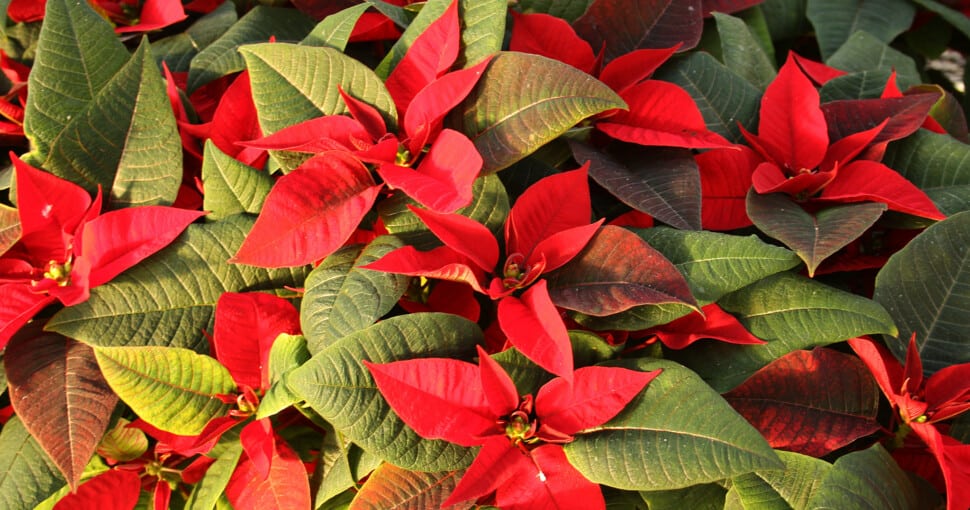Poinsettias have become synonymous with Christmas. For many cultures, decorating the Christmas table with a poinsettia centerpiece has become an essential tradition. Ironically National Poinsettia Day is near Christmas, on the twelfth of December. It celebrates Joel Poinsett, who brought the poinsettia to the United States.
Poinsettias (Euphorbia pulcherrima) are part of the Euphorbiaceae family. They grow indigenously in Mexico and Central America. In The United States, approximately seventy million poinsettias are sold during the six-week period around Christmas. It is not surprising that they are sometimes referred to as the Christmas flower or plant.
Poinsettias grow as small trees or shrubs with a maximum height of thirteen feet. Although poinsettias can grow to this height, many are smaller due to the local climate or environment. Poinsettias grown in a pot seldom grow very big and usually remain less than one foot tall.
Poinsettias have soft green stems that may harden and darken as the plant matures. The leaves are dark green and between two and six inches long. The red ‘flowers’ of poinsettias are not true flowers. They are bracts or modified leaves that have a reproductive function. They turn red in response to the shorter, darker days of winter.
Poinsettias sold in Southern Hemisphere climates where Christmas occurs during summer have been manipulated to ensure the bracts are red. They are usually exposed to fourteen hours of darkness every day for six to eight weeks to achieve the color change. During other times of the year, the poinsettia bracts are green.
Poinsettia bracts are not all red. Some may be pink or apricot. Poinsettias have small insignificant flowers that bloom for a short period and are not usually noticed by gardeners.
1. Anthuriums
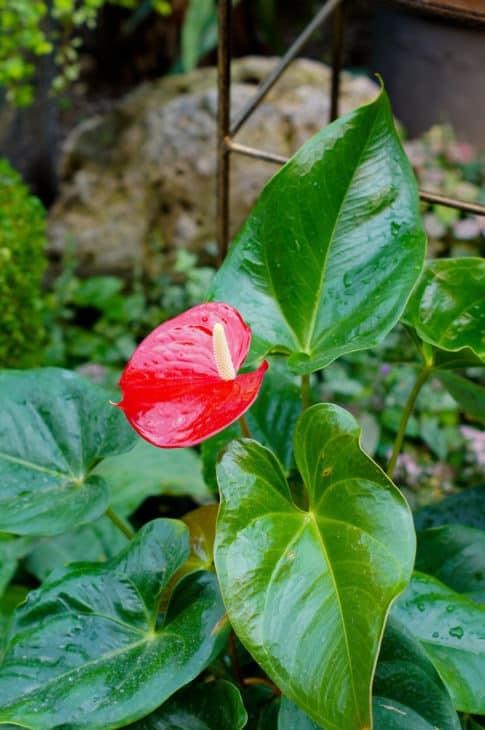
Anthuriums are part of the arum or Araceae family. They are also known as flamingo flowers, flamingo lilies, tail flowers, laceleafs, oilcloth flowers, and boy flowers. They are striking plants combining red and green similar to poinsettias, making them popular for Christmas decorations.
Anthuriums grow indigenously in Mexico, the Caribbean, and Argentina. They are propagated by seed and cuttings and are now cultivated in countries worldwide.
Anthuriums may grow on the ground as terrestrial plants or as epiphytes on other plants. The glossy green leaves are clustered, shaped like a shield. They have prominent veins, which make the leaf surface look slightly crenulated.
Like poinsettias, anthuriums’ red ‘flowers’ are not true flowers. In the case of anthuriums, they are spathes which are also a form of bracts. The spathes can be various colors, but the most popular and striking cultivars have red spathes.
A spadix arises from the center of the spathe. In some cultivars, it is elongated, but in others, it may be round. The red anthurium usually has an elongated green spadix.
Anthuriums can be grown outdoors in shady areas in mild climates. They need plenty of water and rich fertile soil. They are a popular indoor plant and thrive in the lower light. Potted anthuriums need to be fertilized with a weak solution every week.
2. Crotons
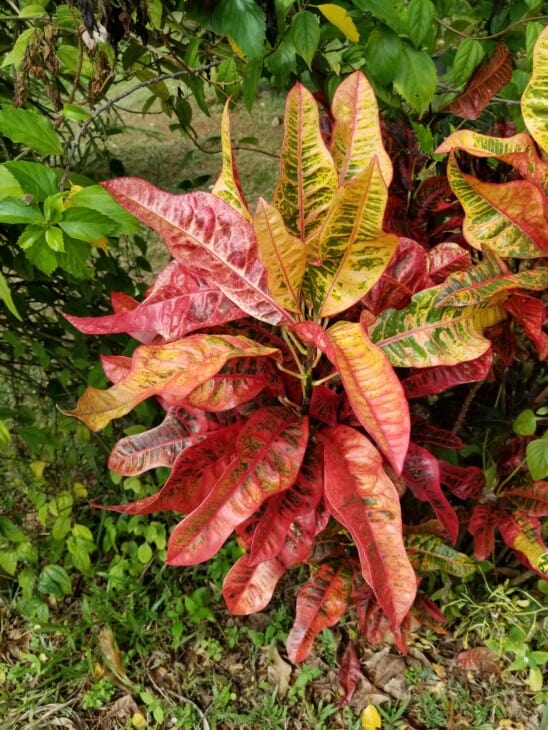
Crotons (Codiaeum variegatum) are perennial, like poinsettias, evergreen shrubs from the Euphorbiaceae family. A common name for crotons is rushfoil. Crotons grow indigenously in Southeast Asia.
Crotons have thick leathery leaves that have variegated colors. The base color is green, and additional colors include red, pink, yellow, orange, purple, white, and apricot. The combination of green with the bright color is strongly reminiscent of poinsettias.
The leaves of crotons provide all the color. The red hues almost look like fire. The flower is small and insignificant, looking more like a small bulb with extensions that shoot outward.
Crotons can be grown indoors or outdoors. A crucial factor in their growth is receiving sufficient light. Their colors fade with poor lighting, and the plant does not thrive.
They have high humidity needs, which must be kept in mind when deciding where to plant your croton plant. Crotons grow best in moist, well-draining soil.
Crotons are plants from a warm climate that need to be kept warm when planted in colder climates. For this reason, many people prefer to keep them in pots which may be moved outdoors during summer and indoors during winter.
3. Peperomia Rosso
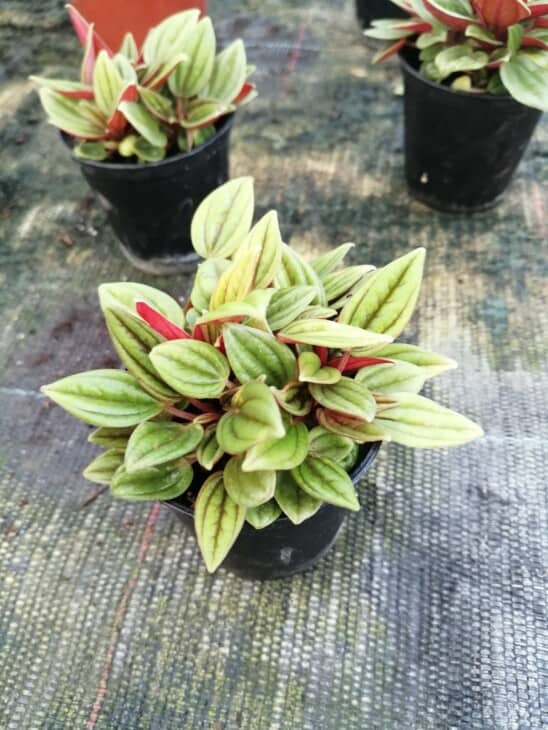
Peperomia are part of the Piperaceae or pepper family. They originate in tropical and subtropical regions in South and Central America, Africa, Asia, and Oceania. Peperomia Rosso is also known as Peperomia Eden Rosso or Peperomia Caperata Rosso.
Peperomia Rosso has thick succulent-type pointed leaves that are dark green on their upper surface. They have an upward growth pattern, displaying their lower surfaces which are intense red. This provides a combination of green and red similar to poinsettias.
Peperomia Rosso is a hybrid of Peperomia metallica and Peperomia marmorata. It grows tall flower spikes that are cream or reddish-cream. Th flowers appear as the daylight hours shorten.
Peperomia Rosso needs bright indirect light, so it is best planted in the shade or kept indoors. The soil should be moist and humidity relatively high. Misting the leaves is helpful if the environment is dry.
Good drainage is essential to keep the plant healthy, and water should be provided regularly to prevent the soil from drying. Peperomia need rich soil with a full range of nutrients, so supplying weekly diluted fertilizer is advisable for indoor plants. Outdoor Peperomia Rosso should be planted in well-composted soil.
Related: 10 Plants That Look Like Peperomia
4. Red Caladiums
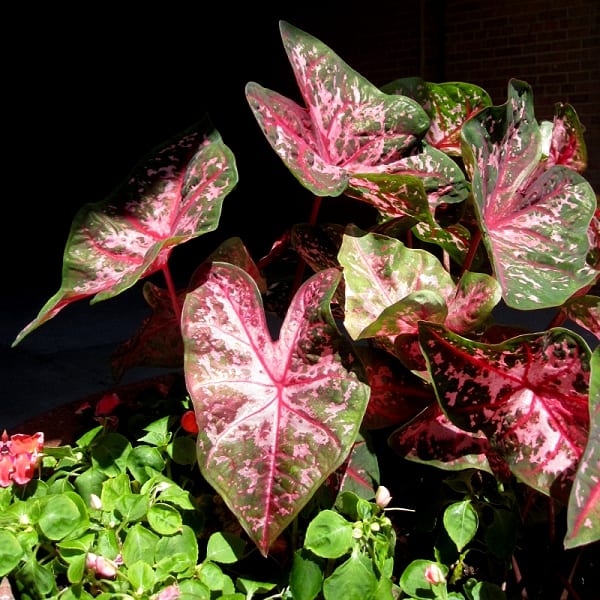
Red caladiums are part of the Araceae or arum family. They are known as elephant ears, heart of Jesus, and angel wings. Red caladium forms part of the Caladium Bicolor species.
They originate in South and Central America, where they grow on river banks, the edges of forests, and small stands of trees. They vary in size from fifteen to thirty-five inches.
The leaves are large, shaped like an arrowhead, and six to eighteen inches long. Red caladiums combine red and green in varying patterns on the leaves.
They may have red centers and green edges or have a green background interspersed with red speckles. Some have green edges with a pink inner leaf and dark red vein lines.
These are some red caladium cultivars:
- Bombshell
- Flare
- Florida Red Ruffles
- Freckles
- Freida Hemple
- Heart to Heart Bottle Rocket
- Heart to Heart Fast Flash
- Heart to Heart Heart’s Delight
- Heart to Heart Hot 2 Trot
- John Peed
- Postman Joyner
- Red Frill
- Red Flash
The combination of red and green are similar to poinsettias, and red caladium could be a good substitute.
5. Polka Dot Plant
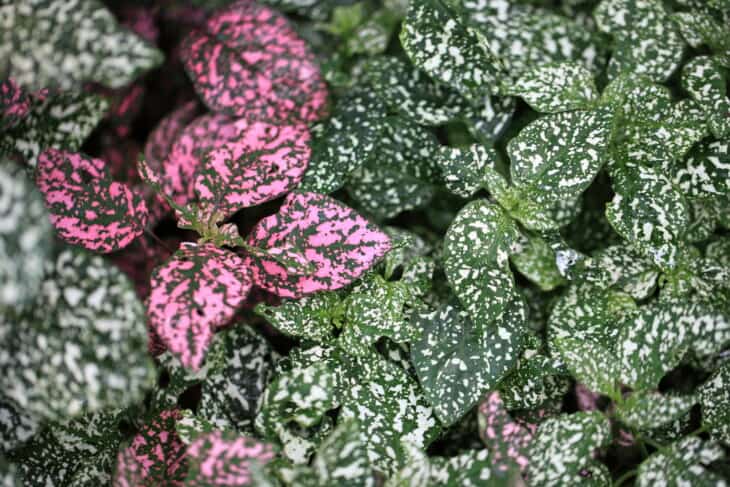
The polka dot plant is classified under the Acanthaceae family. Its official name is Hypoestes phyllostachya, which is quite a mouthful.
They grow indigenously in South Africa, Madagascar, and Southeast Asia. Polka dot plants usually grow in the undergrowth, protected from direct sunlight by larger shrubs and trees.
The polka dot plant is an evergreen bushy shrub that grows only about twelve inches tall and broad. Some cultivars are larger and can grow to about two feet, but most are small.
Polka dot plants prefer warm climates and, as a result, do not cope well outdoors in cold environments. They are usually grown in pots in cool climates with short summers.
The leaves look like they have been liberally dotted or splashed with cream, red or pink paint, giving rise to their common name.
Hypoestes phyllostachya Camina has dark green leaves with carmine red dots.
Hypoestes phyllostachya Red Splash has a green background with red splashes.
The combination of the green and red leaves makes it resemble poinsettias, and it could be an acceptable replacement plant if a poinsettia is unavailable.

